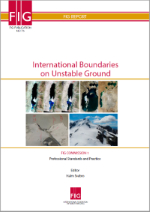News in 2022 
|
FIG and the sustainable Development Goals - Commission 3
October, 2022
FIG Task Force on FIG and the Sustainable Development Goals together
with the ten Commissions have worked on their role on the sustainable
development goals relevant for their Commission.
Commission Chair Hartmut Müller gives his Statement on the
sustainable development goals in relation to Commission 3 -
Spatial Information Management
|

|
Commission 3 addresses a number
of thematic areas, in particular management of geospatial information
about land, property and marine data. The Commission supports the SDGs
by providing guidance on benefits and good practices of using geospatial
information. The lack of available data is a key challenge that hinders
monitoring the SDGs at the local level.
Comprehensive, consistent, reliable, and timely data are critical for
measuring progress towards sustainability objectives.
Commission 3 focuses on the management of geospatial information
about land, property and marine data; spatial data infrastructure – data
collection, analysis, visualisation, standardisation, dissemination, and
support of good governance; knowledge management for geospatial
information management; business models, public-private-partnerships,
professional practice and administration.
Importance of relevant data sources
Space can be used as a concept which specifies how the transition to
sustainability can be achieved in a spatial context, for example for a
city or region. Land use plans and urban simulations are tools that
provide explicit spatial guidance for development. Today they rely on
geospatial data and might be even more data-driven in the future. This
is even truer if relevant data sources can be identified and benefits
are explained to the stakeholders.
Geospatial data specialists are usually not involved in decisions
about what strategy to pursue for a sustainable development, and
probably cannot determine what is considered sustainable in a particular
scenario. But when it comes to implementation, it is important to point
decision-makers and others to what data sets are needed (and what is
missing) to successfully navigate the path to sustainability, and how
this data has to be processed to extract meaningful information from it.
In this context, direct dialogue between (geospatial) data scientists
and decision makers, planners and the public is indispensable.
Interdisciplenary approaches, analyzes & visualisations
Geo-ICT is a cross-cutting technology. If the usage of spatial data
for a certain domain is debated, such as on climate or disaster
management, interdisciplinary work becomes inevitable. Space offers a
bridge, since spatial visualisations such as maps use a language that is
universally comprehensible. It helps to establish a common understanding
of experts from different disciplines, each with their own technical
vocabulary. The beneficial interplay of space, data and sustainability
becomes particularly evident in the smart city context. Much of the
(big) data used in smart city applications is spatially referenced and
multiple tools have been developed to extract information from it.
Increasing spatial data availability and the capability to process,
analyze and visualize this data with GIS software make such instruments
more and more efficient. In this way, geospatial information helps
bridging the gap between technology, vision, and strategic planning and
contribute to inclusive and participatory smart cities, villages, or
regions, all of which require more than just technical solutions.
Overcoming challenges
However, there are significant challenges to overcome. The lack of
available data is a key challenge that hinders monitoring the SDGs at
the local level. Participatory mapping can fill this data gap to some
extent and add local knowledge. Comprehensive, consistent, reliable, and
timely data are critical for measuring progress towards sustainability
objectives. Geospatial data, whether collected by volunteered geographic
information or by surveyors and other experts, must be assessed whether
their quality is sufficient for a particular use case.
The integration of more and more data sets, whose quality may be
unknown to the end user, adds to this challenge. At the same time, more
holistic approaches of information provision are necessary in the face
of complex crises and the wish to join pathways towards sustainability.
Consequently, further (spatial) data, e.g. statistical data sets, must
be integrated. The values of these data sets, however, can differ
considerably due to varying approaches used for data gathering or
processing.
Another key challenge is data privacy. Working with many sensors and
at the same time combining different sensor types provides information
that can advocate efforts for sustainable transitions. However, the use
of big (spatial) data brings the issue of privacy and data protection to
the fore.
Exploiting the potential of spatial data for the SDGs
Spatial data are key to sustainability, but their potential does not
yet seem to be fully exploited. Interoperable open data provision
through SDIs and open data portals can contribute to solve this problem.
Against this background, authors from FIG Commissions 3 and 8, the
FIG Young Surveyors Network, and the Volunteer Community Surveyor
Program have collaborated to design and write a publication titled
'Geospatial Data in the 2020s - transformative power and pathways to
sustainability’.
The publication highlights the impact of geospatial data for spatial
planning, health, diversity, volunteerism, cadastre, and the property
market in the 2020s; it will be officially launched at the FIG Congress
2022 in Warsaw, Poland.
In conclusion, Commission 3 supports the SDGs by providing guidance
on benefits and good practices of using geospatial information.
Hartmut Müller and Paula Dijkstra
October 2022




































